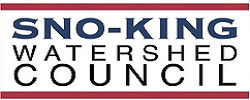Introducing SnoKing Watershed council’s newest appeal project, Pinecrest Pointe Development. Brought to you by the same developers of Ironwood. SKWC in partnership with Hilltop-Locust Community Group (HLCG) appealed this development 9/18/2020.
The Pinecrest Pointe project is located at 21621 Cypress Way, Lynnwood and is a six?lot single?family residential short plat. The proposed infiltration facility is perched directly above a steep, sensitive slope, owned by private citizens with a Seattle City Light easement for high voltage powerlines, that has been designated an erosion hazard area and a landslide hazard area, and Swamp Creek with its population of federally listed salmonid species is approximately 150?feet downslope from the infiltration pond. Failure of the Pinecrest Pointe pond will result in massive sediment delivery to Swamp Creek adversely impacting macroinvertebrate numbers, which provide food for fish and other riparian wildlife, as well as the destruction of salmon spawning areas. Risking such an event is contrary to the money and efforts that have gone into stream and salmon restoration efforts over the last several decades by SKWC and other organizations.

Erosion hazard areas are, “areas containing soils which are at high risk from water erosion.” The area downslope from the infiltration facility is a geologic hazard area, because of its susceptibility to erosion, sliding, earthquake, or other geologic events. Geologic hazard areas are not suited to the siting of commercial, residential, or industrial development consistent with public health or safety concerns.
Groundwater seeps (e.g. groundwater leaking into the excavated test pit) were noted during the late spring months when test pits were excavated at the proposed stormwater infiltration facility at only 6?inches below the proposed infiltration pond bottom. The County’s 2017 Drainage Manual requires a minimum separation of 5?feet between the bottom of the pond and the seasonal high groundwater, otherwise the groundwater will displace stormwater storage in the pond during winter storm events. The 5?foot separation is required to allow stormwater to be treated (filtered from heavy metals, pesticides and other man?made chemicals washed into the system by rainwater), before entering the sensitive stream environment. Without the 5?foot separation, code required treatment of stormwater is not provided.
While the developer has downplayed the severity of the seeps as being minor and of no consequence, any seepage into the pond reduces the storage capacity of the pond. In addition, the required setback distance of 200?feet has been reduced to a barebones 50?foot separation. This increases the risk of pond failure that sits directly above a Seattle City Light, critical infrastructure in an easement on private property. Failure of the pond for whatever reason will threaten both the Seattle City Light transmission tower and Swamp Creek, but also the safety of the owners of this private property and others downstream.
We are appealing this development because:
- The counter flow design of the conveyance overflow pipe is not allowed.
- Geotechnical Calculations were not checked.
- Stormwater Infiltration Facility is constructed in a sensitive area.
- High Groundwater Prevents Stormwater Infiltration at this Site
The Hearing Examiner should have denied the Applicant’s proposal for failure to comply with the County Code. The Hearing Examiner’s decision to approve the proposal notwithstanding the violations should be reversed under SCC 30.72.120(2), because the Hearing Examiner committed the foregoing errors of law and failed to support his decision with substantial evidence, which are grounds for reversal under SCC 30.72.080(2)(c), (d).
What you can do:
While we are starting the appeal process, you can Contact the County Council contact.council@snoco.org and tell them to:
- Revise the code to require PDS to independently check all calculations, any time a setback is reduced less than 200-feet from a sensitive area such as an erosion hazard or landslide hazard area and have the developer pay for this service.
- Revise the code to prohibit early demolition on sites with pending Land Disturbing Area (LDA) permits, until all appeals are exhausted.
- Revise the code to allow appellants reasonable right of entry to project sites to perform their own geotechnical, wetland, and other observations so that a one-sided opinion of the development can be challenged.
- Revise the code to allow the public to testify at Type II hearings and allow for the introduction of new evidence.
Thank you for your support and we will keep you updated on new information.
